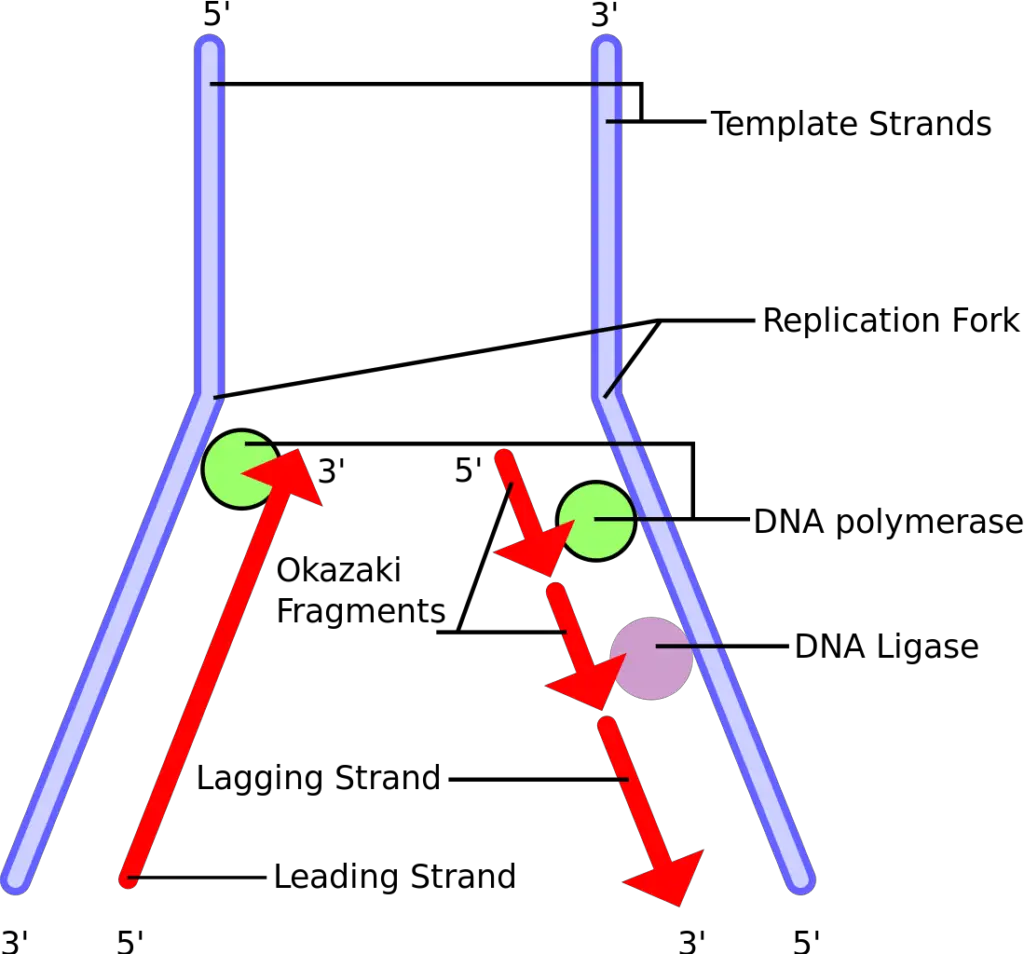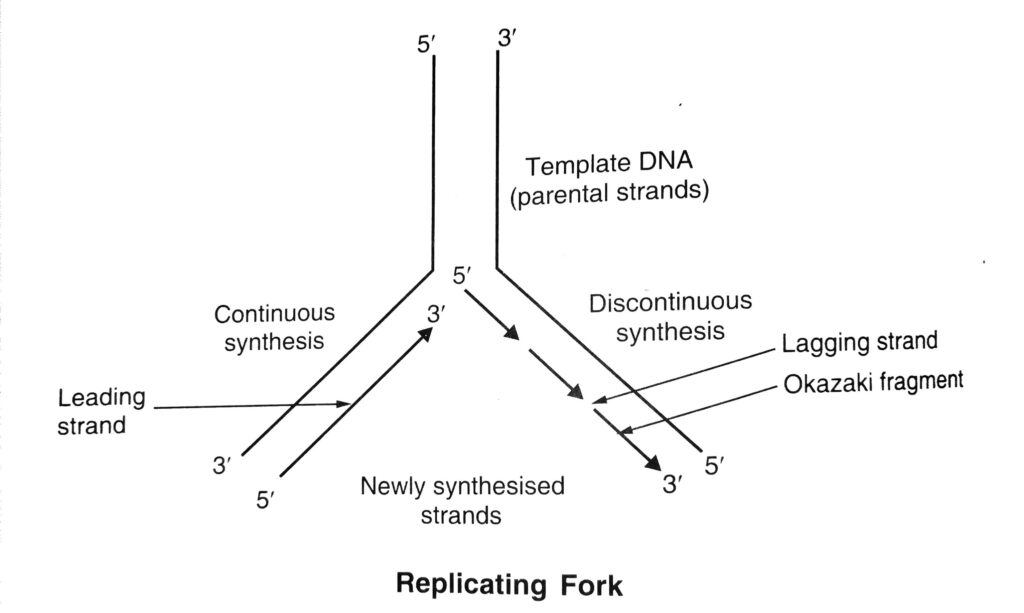Difference Between Leading Strand And Lagging Strand of DNA
In this post, we will know about the key differences between the Leading Strand and Lagging Strand of DNA. After reading this post, you can perfectly differentiate the two of these very clearly.
Make sure to read this complete post to understand the topic very clearly and precisely.
Both the leading strand and the lagging strand of DNA are the newly synthesized DNA strands formed during the process of DNA replication.
The leading strand as the name suggests is a complete continuous strand that is synthesized rapidly during DNA replication on the 3’→5′ polarity template of DNA. Its direction is 5’→3′.
Whereas, the lagging strand as the name suggests, it lags behind and is always very slowly synthesized in the form of various small fragments on the 5’→3′ polarity template of DNA. Its direction is 3’→5′.
The importance of these two different strands in two different directions is very much necessary for DNA replication to occur smoothly.
Both the leading strand and the lagging strand maintains the antiparallel nature of the two DNA strands, maintains the balance for the proper hydrogen bonding between the two strands, maintains the complementary base pairing, and leads to the synthesizing of new strands always in the 5’→3′ direction.
Let’s know more about them with precise detail and comparison.

Sdemarre / CC BY-SA
Comparison Chart: Leading Strand Vs. Lagging Strand
| No. | Leading Strand | Lagging Strand |
|---|---|---|
| 1. | It is the new strand of DNA that grows continuously. | It is the new strand of DNA that grows discontinuously. |
| 2. | No fragments are seen during the synthesis of a leading strand. | Various fragments are seen during the synthesis of a lagging strand. These fragments are called Okazaki fragments. |
| 3. | DNA ligase enzyme is not required for its growth. | DNA ligase is required as it joins the various Okazaki fragments together. |
| 4. | The direction of growth of the leading strand is 5′→3′. | The direction of growth of the lagging strand is 3′→5′. |
| 5. | No fragments are seen and the direction of the lagging strand is completely in the 5’→3′ direction. | Okazaki fragments are seen and these fragments are synthesized in 5′→3′ direction. Although, the template is in 3’→5′ polarity direction. |
| 6. | Only a single RNA primer is required for the whole lagging strand to synthesize. | The starting of each Okazaki fragment requires a new RNA primer. |
| 7. | The formation of leading strand is rapid. | The formation of the lagging strand is slower. |
| 8. | This strand is synthesized towards the direction of the replication fork. | This strand is synthesized opposite to the direction of the replication fork. |
| 9. | The formation of leading strand begins immediately at the beginning of replication. | The formation of lagging strand begins a bit later than that of the leading strand. |
| 10. | It is synthesized during the replication of DNA. | It is also synthesized during the replication of DNA. |
| 11. | DNA primase enzyme can work only in the 5’→3′ direction. | DNA primase enzyme can work only in the 5’→3′ direction. |
| 12. | During the synthesis of leading strand, only one site of initiation is exposed in the template strand. | During the synthesis of lagging strand, multiple sites of initiation are exposed in the template strand. |
| 13. | In DNA replication fork, it’s template opens in the 3′ and closes in the 5′. | In DNA replication fork, it’s template opens in the 5′ and closes in the 3′. |
| 14. | The polarity of the leading strand is 5′→3′. | The polarity of the lagging strand is 3′→5′ after the fragments are joined by DNA ligase. Though the polarity of each Okazaki fragment is 5′→3′ if it’s unjoined. |
| 15. | Its template opens in the 3’→5′ direction. | Its template opens in the 5’→3′ direction. |
Definition of Leading Strand
The newly continuous synthesized strand of DNA that grows in the 5’→3′ direction is the leading strand of DNA. The template of the leading strand is with 3’→5′ polarity.
During DNA replication, the new strand is replicated in the 5’→3′ direction which is the direction towards the replication fork. DNA is added to the leading strand continuously, with the rate of one complimentary base at a time.
This strand is a continuous strand with no fragments because the DNA primase enzyme can work only in the 5’→3′ direction, and this actually matches the newly forming strand’s antiparallel nature with that of the template strand with 3’→5′.
DNA-dependent DNA polymerase enzymes act as a catalyst for synthesizing new strands. And, the DNA Primase generates short strands of RNA that bind to the single-stranded DNA to initiate DNA synthesis by the DNA polymerase.
During the synthesizing of the leading strand, there’s only a single primer available in the 5′ end of the leading strand. This primer serves to prime and lay a foundation for the DNA synthesis of the leading strand to take place continuously.
What’s the primer? A primer is a short nucleic acid sequence that provides a starting point for DNA synthesis.
Definition of Lagging Strand
The newly discontinuous synthesized strand of DNA that grows in the 3’→5′ direction is the lagging strand of DNA. The template of the lagging strand is with 5’→3′ polarity.
During DNA replication, the new lagging strand is replicated in the 3’→5′ direction though in each Okazaki fragment it is 5′→3′.
DNA is added to the lagging strand discontinuously with the formation of various fragments because the DNA primase enzyme cannot work in the 3’→5′ direction. And so, for maintaining the antiparallel nature of DNA the lagging strand is synthesized discontinuously.
The discontinuous segments of the DNA lagging strand are known as the Okazaki fragments. These fragments are later joined together as one complete strand by the enzyme DNA ligase.
The synthesizing of the fragments of the lagging strand is always in the direction away from the replication fork.
Moreover, during the synthesizing of the leading strand as small-small fragments, every fragment has a primer available in the 5′ end. Later when the fragments are joined the primers are removed altogether.
Key Differences Between Leading Strand and Lagging Strand
1. Both are replicated strands of DNA. The leading strand grows continuously whereas the lagging strand grows discontinuously.
2. The direction of growth of the leading strand is 5′→3′. Whereas, the direction of the lagging strand is 3’→5′.
3. Only one RNA primer is required for the leading strand. Many RNA primers are required for the lagging strand.
4. The leading strand is synthesized towards the direction of the replication fork. The lagging strand is synthesized opposite to the direction of the replication fork.
5. The leading strand is rapidly synthesized. The lagging strand is slowly synthesized.
6. The leading strand is a complete strand. The lagging strand is not a complete strand and shows fragments called Okazaki fragments which later joins together by DNA Ligase forming one single strand.

How the Leading Strand and Lagging Strand are formed
During the process of DNA replication, the main enzymes are the DNA helicases that separate the double-stranded DNA into single strands allowing each strand to be copied (synthesized) into a new strand.
We know that the DNA double helix is very stable. So, energy needs to be provided in the form of ATP in order to separate the two strands together.
So, both DNA helicases and biochemical energy of the cell is required to initiate DNA replication with the separation of the two strands.
Separation of the strands is an energy-expensive process and during this process, the deoxyribonucleotide triphosphates perform two functions. First is acting as a substrate, second is providing energy from the two terminal phosphates.
As the biochemical energy is provided, the intertwined strands of DNA separate at the origin of replication.
As the two strands cannot unwind in the entire length of the DNA molecule due to high energy requirement, therefore, the replication starts with a small opening of DNA helix. This results in the formation of the Y-shaped structure called the replication fork.
The replication fork looks like a fork in the DNA that is composed of the two separate strands of the DNA called template strands.
One template strand is in 5’→3′ direction and the other is in 3’→5′ direction.
The two separate strands of the DNA are called template strands because the template strand in 5’→3′ direction will synthesize the lagging strand. Whereas, the template strand in 3’→5′ direction will synthesize the leading strand.
That’s how the Leading Strand and Lagging Strand are formed.
Clear Your Confusion Between The Leading Strand And The Lagging Strand
Most of the newbies often get confused with the direction of replication of the new leading strand and the lagging strand of DNA.
And why they won’t because there’s a catch? We’ll understand it clearly here in the part of the post.
The main thing is that the DNA strands are antiparallel to each other. This means that one strand is from 5′ to 3′ direction and the other strand is from 3′ to 5′ direction.
And moreover, DNA polymerases can only make DNA in the 5′ to 3′ direction, and this causes a real problem during replication as the newly synthesized strand needs to be antiparallel as well.
So, what happens is that the leading strand runs 5′ to 3′ continuously without any fragmentation because the DNA polymerase is also moving in the same direction as the replication fork.
But, when it comes to lagging strand it can be seen that the DNA polymerase is moving in the direction away from the replication fork. And so the polymerase must come off and re-attach on the newly exposed DNA in order to maintain the antiparallel nature of the lagging strand. Thus, it leads to the creation of Okazaki fragments.
